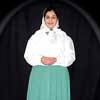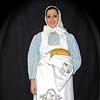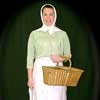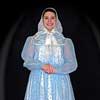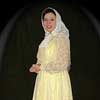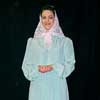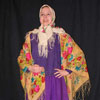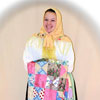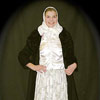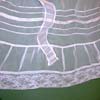Fashion Part 1 Fashion Part 2 Fashion Part 3
Women's Traditional Doukhobor Suits
After the end of the hand woven linen era, the availability of commercial fabrics produced colorful outfits – a change to traditional Doukhobor women’s clothing. The traditional woman’s Doukhobor suit consists of a front pleated skirt and a long sleeved blouse. Until the 1950s it was common to have the blouse sewn from a fabric that was not the same as the skirt fabric, both in texture and in color.
(image01 image02 image 03)
Women’s wedding ensembles in the 1950s started a trend of having both the blouse and the skirt sewn from the same fabric. Access to commercial patterns, especially for blouses, produced a variety of different fashionable styles. Soon the choirs and the general female population embraced the change. This new fashion generated a need in each community for more seamstresses who excelled at sewing these ensemble.(image04 image05)
Since the 1970s the number of these artisans has diminished due to the growing number of young women working “outside the home” and the Doukhobor dress is no longer emphasized by the younger generations. Due to the variety and suitability of store bought women’s fashions, Doukhobor women started purchasing outfits that resembled the traditional ensemble and now, at the beginning of the 21st century, they are wearing them to moleniye (prayer services) and funerals. The formal ensembles are still appropriate for choir stage performances and special occasions linked to Doukhobor cultural activities. Dependent on current fashion and fabric, the changes to the traditional Doukhobor ensemble continue to this day. (image06)
Zanaveski
A Doukhobor immigrant woman arrived from Russia wearing a “zanaveska” or apron which often matched the skirt of the traditional Doukhobor ensemble. Some aprons were of plain or printed cottons. During the pioneer years, an apron was part of a woman’s every day costume worn over the full skirt while she worked in the house and in the field.
The decorative “Sunday best” or bridal “zanaveska” was made from finer wool but of the same dark color as the traditional blouse and skirt. A section of woven fabric stripes of different pastel colors was sewn on for contrast. The final knitted edge was of red wool measuring 5 1/2 inches. Contrasting thread was used to attach the trim. (image07)
In the 1930s, the purpose of the zanaveska changed making this “apron” more decorative than practical in the Sunday best outfits. With the addition of store bought textiles, sheer fabrics became the popular material to embellish with pintucks and laces. The bridal ensemble included a colored zanaveska with a contrasting ribbon sewn into the design along with the traditional pintucks. (image08 image09 image10)
By the 1950s, Doukhobor fashion excluded the zanaveska as part of the traditional ensemble. Presently, the zanaveska is featured in choir ensembles as part of a heritage costume. Many are preserved only as heritage items.
To Previous Page in this Section To Next Page in this Section

